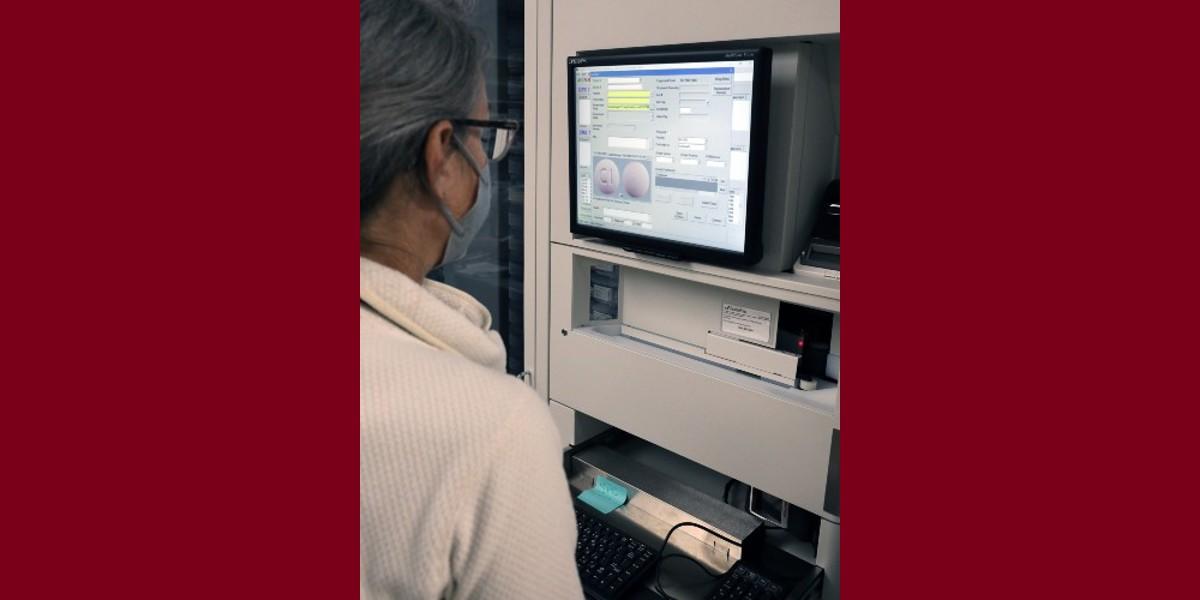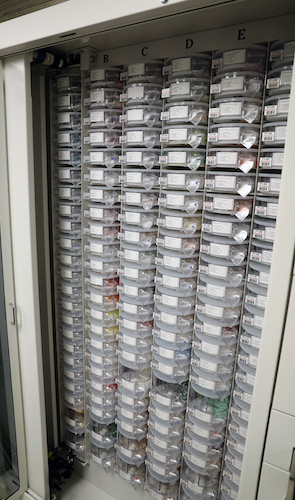Faster, safer prescriptions
New technology helps the Lewis Small Animal Hospital increase patient safety

New technology helps the Lewis Small Animal Hospital increase patient safety
Prescription orders are verified at the machine’s terminal. | Photo by Martin Moen
Imagine having to count an exact number of the correct item, put them in a container with the correct labeling, and never make an error. Ever. And repeat that perfection more than 150 times a day for your entire career.
That used to be the routine for the medication dispensary staff at the Lewis Small Animal Hospital. Thanks to new technology installed this spring, the risk of a mistake and some of the repetitiveness of filling prescriptions has been reduced.

Like an over-sized refrigerator, the new machine sits in a corner of the hospital’s dispensary awaiting instructions, which can be entered from terminals in locations around the building. On one side of the machine are 135 bins containing the pills and capsules most often prescribed by the staff veterinarians. When an order is submitted, its robotic arm collects the correct number of pills from the correct bin and drops them into a plastic bottle, which then moves on a small conveyor belt. The machine prints a label with all the required information, and applies the label as the bottle spins on the belt. The bottle then moves to the front where a technician scans the barcode on the label to review the contents and labeling to ensure it all matches the information shown on the computer monitor.
“Grabbing the right medication, counting pills, and labeling bottles are tasks that a machine can do faster and more accurately,” says Dr. Scott Wood, Pharm.D., FSVHP, the hospital’s clinical pharmacist. “This technology allows our staff to work to the full extent of their license. They use barcode technology to assure the prescription is filled with the correct medication. Using the robot for the filling task allows the dispensary staff more time to identify potential drug interactions, verify the medication is appropriate for the patient, and verify that the dosage is correct for the patient. Those checks and balances are critical for our patient’s safety. Introducing technology doesn’t eliminate the need to always verify every prescription.”
The new machine helps everyone stay accurate. It is programmed with the bar codes used by drug manufacturers, and won’t allow workers to load a medication into the wrong bin. With proper setup by staff, it can accurately count the tablets and capsules most often prescribed in the hospital. It also is programmed to print all the appropriate advisories and required warnings on the label. And, it is always on duty.
“We are getting used to our new routines,” says Anne Johnson, CVT, the supervisor of the unit’s technicians. “We are used to a fast-paced, high-risk environment. This gives us greater assurance that everything we do is correct–and that’s a great feeling at the end of a busy day.
The robotic machine has space for 135 different medications, but can only handle those that come in tablet or capsule form. Prescriptions for liquids, ointments, compounded medications, and refrigerated products are filled the traditional way–by hand. “Most of us got into this field knowing that precision with routine tasks was critical to success,” Johnson says. “So, filling a few of these each day gives us that sense of accomplishment. Of course, knowing that we are helping to save and extend the lives of beloved pets is still number one.”
The technology has been used in human medicine for decades, yet has not been widely adopted in veterinary hospitals. Increasing patient safety and dispensary efficiency led Dr. Wood to make the decision to lease it. “Another benefit of the machine,” Wood says, “is that it helps to manage inventory more effectively so we can keep costs low for our clients.”